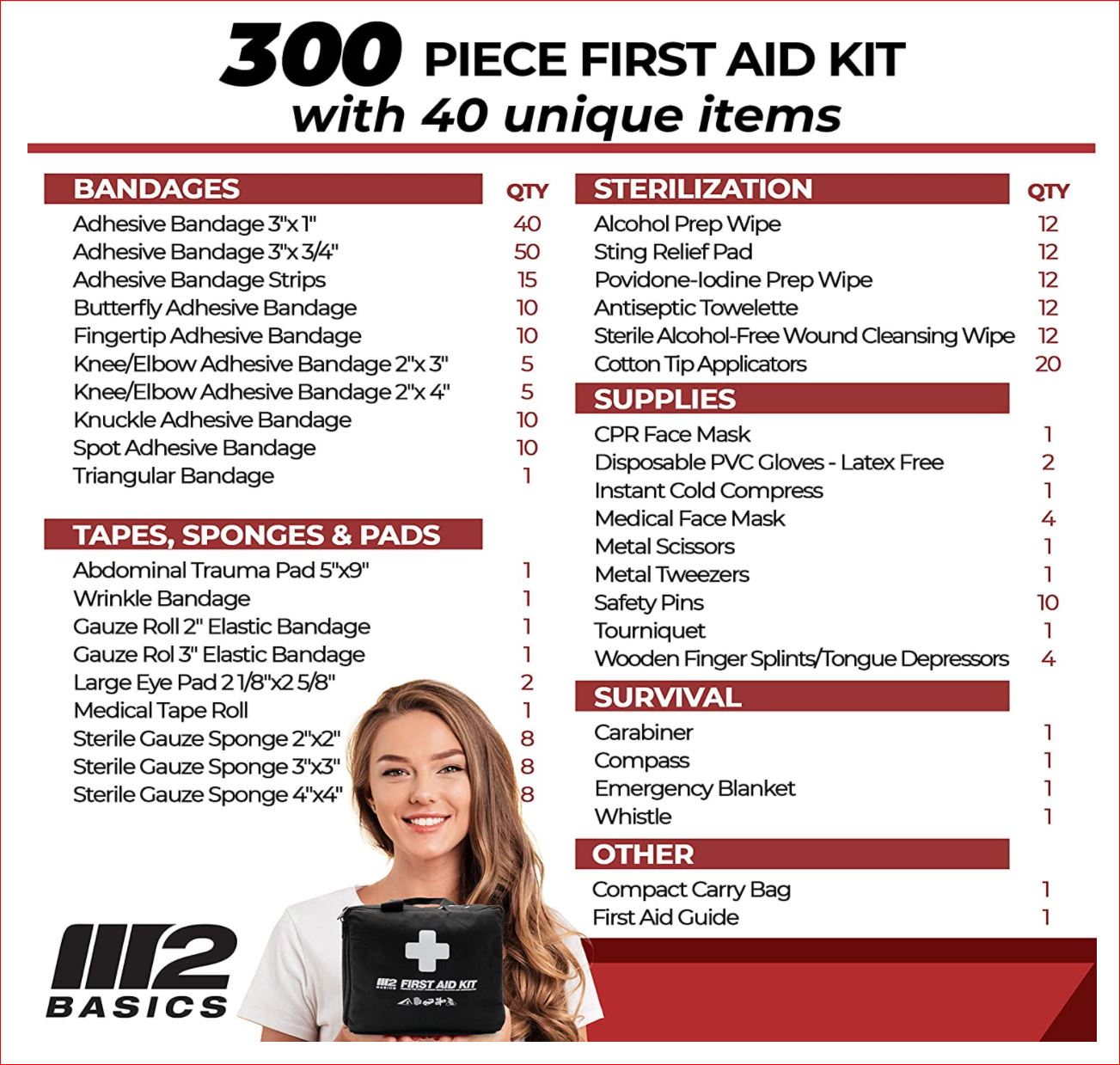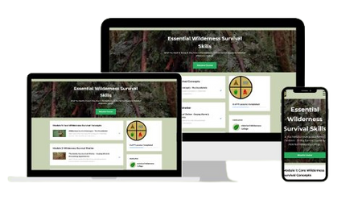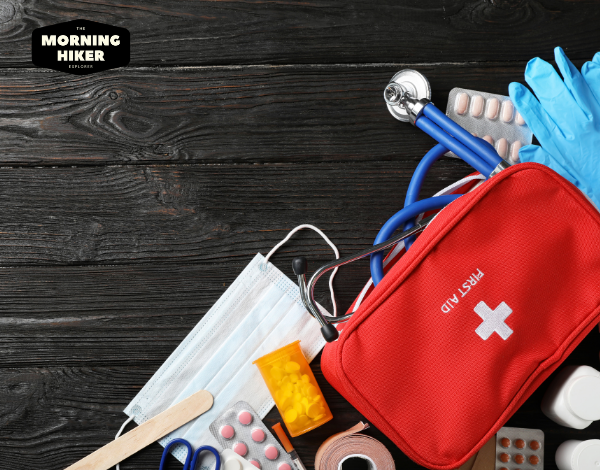A First Aid Kit is a must-have for any outdoor activity. Hiking is no exception – a blister, sunburn, bug bite, or cut can ruin your day, and a sprained ankle could turn it into a disaster. Every time you go hiking, make sure you have a fully stocked first aid kit.
We carry the M2 Basics first aid kit. Before I break down what is in the kit, let me tell you a story:
This post contains some affiliate links to products that I use and love. If you click through and make a purchase, I’ll earn a commission, at no additional cost to you. Read my full disclosure here.
In This Article
Why You Need A First Aid Kit
I have a friend who used to hike a lot. He would pack up his three (3) dogs, two kids, and wife and hit local trails. When friends and family came from out of town, hiking was one of the things on their agenda. I often joked with him that the reason he loved to hike was to simply keep everybody from crowding his home.
When his father came for a visit, they did what they always did – hit a local trail. His dad was over 60 and in relatively good health. This was his first time in the mountains on ‘natural’ trails. About midway through the hike, he slipped on a rock and broke his ankle. They managed to make it back to their vehicle and get him medical attention.
One year later he was visiting again. After a lengthy discussion, he assured them he was up to hiking with them. So they went to a trail they were familiar with and started their day trip.
About a mile from the trailhead, he slipped (again) and broke his ankle. Two for two.
Needless to say, my friend says he will never hike with his father again. Can’t say I blame him.
The upside to the story is they were prepared for both occasions. They always hike a fully stocked first aid kit. They were able to bandage his ankle and properly care for his wound on the trail. They made a make-shift crutch and hiked their way out.
During my time in the mountains, I’ve come across people with a variety of injuries. Unfortunately, most of the time people aren’t prepared. They have no first aid supplies or a plan to know what to do in case of emergencies.
M2 Basics 300 Piece First Aid Kit: The Tool We Use

The M2 Basics first aid kit is a kit you can carry with you on a hike to help with any minor to moderate injuries that might occur. It is different from a medical kit that you would keep in your house because it is made to be compact enough to fit in the pocket of your backpack.
This is important because the last thing you want is to have to drag a large medical kit along with you on your hike. The kind of small first aid kit that you will want to carry on you will be small enough to carry in the palm of your hand, yet all the supplies that you might need when you are on the trail.
Why we like the M2 Basics Kit
It’s compact enough to fit in my backpack (which I carry on all hikes and on our boat), but it has a variety of items; everything we need for a minor emergency situation (common injuries).
Designed for the backpacker or hiker, the M2 Basic First Aid Kit is our most economical first aid kit. It is not intended for use in a medical facility but is a complete first aid kit for the recreational user. This basic first aid kit offers you the essentials for treating minor cuts and scrapes when you’re on the trail or on vacation.
Basic First Aid Kit Supplies
The best way to make sure you’re prepared is to keep a first aid kit in your car, your home, and your backpack. A first aid kit should contain an injury treatment guide, your family’s medical history, and the most common medications needed to combat simple injuries. The M2 Basics First Aid Kit meets all of these standards and more.
The M2 Basics First Aid Kit is a compact, lightweight product that is specially designed to be taken along on your hikes. The kit comes with essential first aid supplies such as bandages, gauze, and a thermometer. We have even included a pair of tweezers in case you need to remove a splinter or tick.
What should be in your hiking first aid kit?
No kit has it all. We recommend looking through your kit to make sure the basics are included. If anything is missing, just add it to your bag.
Essentials to Include in Your Medical Kit
The great outdoors can be a dangerous place, and there’s nobody better to trust your well-being with than you. With this informational blog post, we’re going to explore what essentials you should always have in your hike first aid kit.
Whether you’re an experienced hiker or a newbie, there are some things that should always be inside your first aid kit on any adventure. Each item listed below is imperative to any hiker’s safety.
Bandages: For the obvious reason, these are a must-have for any hiking trip. They are often used for cuts and scrapes, but can also be used for a multitude of other injuries. A great tip is to keep bandages in plastic bags so they stay dry even if the outside of your bag gets wet.
Adhesive Tape: With everything from blisters to cuts, adhesive tape is a necessary item that should be in every hike first aid kit.
Gauze Pads: Gauze pads can be used for a number of things such as blisters and when wrapping injuries. It is recommended to have 3×3 and 4×4 pads for more substantial injuries.
Butterfly Bandages: These are designed in the shape of a butterfly, which helps to cut down on healing time as the wings increase blood flow. Because of this, they’re great for sprained ankles and jammed fingers. There are different sizes available for whatever sort of injury you may need it for.
Antiseptic: Antiseptic is another must-have in your hiking first aid kit, as it can be used to cleanse wounds and also fight infection if need be. Benzalkonium chloride is a common antiseptic that hikers carry because it is highly effective against a variety of microbes.
Pain Reliever: Taking aspirin or ibuprofen for pain, especially in the case of sprains, is a great way to stay comfortable on your hike. Make sure that you’re familiar with the proper dosages to keep you safe.
Sunscreen: Sunscreen is incredibly important when it comes to going hiking in the summer as it can protect against dangerous UV rays that can lead to sunburn and other issues. It’s recommended by many sources to use at least SPF 30 and waterproof sunscreen if you have sensitive skin or are going to be out in the elements for an extended amount of time.
Tweezers: While many hikers may not think to pack this essential item, tweezers are often needed to remove various items from shins or other areas where you would prefer not to have them.
Antibiotic Ointment: This must-have item is used to fight against infection in minor cuts and burns. It’s recommended by many experts to use triple antibiotic ointment when you’re hiking as it fights against bacteria and fungi.
Bug Repellant: One of the worst things that can happen during any hike is getting bitten by a bug, so it’s important that you have something that keeps them away.
Water Purification Tablets: If you’re going to be spending a lot of time outdoors, unfiltered water can be dangerous. Higher-quality tablets like Katadyn Micropur are going to be much more effective than the typical chlorine tablets found at the store, and they’re easy to use at a moment’s notice.
Ace Bandage: An ace bandage is useful for different hikes, depending on the specific injury. They can be used for minor sprains or for holding an injury in place. Ace bandages can be purchased at virtually any pharmacy and often come in a variety of sizes and colors.
First-Aid Pamphlet: When you’re out in the wilderness, it’s always a great idea to have a first-aid quick guide to get you started with different first aid care plans. You should also make sure that you know how to properly administer any medications or treatments in the case of an emergency.

Hand Sanitizer: While this item isn’t something most hikers think about, hand sanitizer is incredibly useful when it comes to fighting off germs and bacteria. This can be used for cleaning your hands after a fall or after going to the bathroom as well.
These are some of the most important items that you could have in your hiking first aid kit. If you’re wanting to be even more prepared, there are other items that you could stock up on such as ibuprofen, bandanas, and a thermometer.
Red Cross Recommended Items for Your First Aid Kit
What goes into your first aid kit is based on your need. What is needed for the home or for camping is much different than what is needed on a work site. However, in general, this is what the Red Cross recommends a kit should contain for a family of four:
The Red Cross recommends that all first aid kits for a family of four include the following:
- 2 absorbent compress dressings (5 x 9 inches) (Similar item available in the Red Cross Store)
- 25 adhesive bandages (assorted sizes), also found within our Family First Aid Kit (Similar item available in the Red Cross Store)
- 1 adhesive cloth tape (10 yards x 1 inch) (Similar item available in the Red Cross Store)
- 5 antibiotic ointment packets (approximately 1 gram) (Similar item available in the Red Cross Store)
- 5 antiseptic wipe packets (Similar item available in the Red Cross Store)
- 2 packets of aspirin (81 mg each) (Similar item available in the Red Cross Store)
- 1 emergency blanket
- 1 breathing barrier (with one-way valve)
- 1 instant cold compress, also found within our First Aid Kit
- 2 pair of nonlatex gloves (size: large)
- 2 hydrocortisone ointment packets (approximately 1 gram each) (Similar item found within the Be Red Cross Ready First Aid Kit)
- 1 3 in. gauze roll (roller) bandage
- 1 roller bandage (4 inches wide) (Similar item available in the Red Cross Store)
- 5 3 in. x 3 in. sterile gauze pads (Similar item available in the Red Cross Store)
- 5 sterile gauze pads (4 x 4 inches) (Similar item available in the Red Cross Store)
- Oral thermometer (non-mercury/nonglass), also within the Deluxe All Purpose First Aid Kit
- 2 triangular bandages (Similar item available in the Red Cross Store)
- Tweezers
- Emergency First Aid guide
Items in the the M2 Basics First Aid Kit
300 items are included in the M2 Basics kit.

Know How To Do First Aid in the Wild
It’s not only important to know what supplies you need when hiking, you also need to know how to use the tools and supplies. A book we recommend is ‘The Survival Medicine Handbook.’ This ought to be on every serious hikers bookshelf. In fact, it’s worth having in your backpack if possible. Especially on overnight or long hikes.

Basic First Aid Kit Cost
What should you pay for a basic hiking first aid kit? it certainly doesn’t have to break the bank. Our kit cost under $30. Check Amazon prices for current costs.
You can find cheaper first aid supplies. (see below). Our choice was based on the fact we use it for multiple purposes.
Along with hiking, we love to kayak and have a pontoon boat. The M2 Basics kit has everything we need to make us feel we are prepared in most emergencies.
Final Thoughts of the M2 Basics First Aid Kit
The M2 Basics First Aid Kit is a great place to start in building a hiking medical emergency kit. It is compact and has the essentials you need to treat all common and minor injuries.
Wilderness Survival Skills Course

In this course, you’ll rediscover the lost knowledge our ancestors had and the key components to become self-sufficient in nature.
- If you like to go hiking, you’ll have the confidence to handle yourself if you get into a difficult situation.
- If you’re ever caught in an accident while travelling or a natural disaster, you’ll know what to do to survive.
- Or if you’re a survivalist who wants to know how to live completely off the land, you’ll have the skills to do so.
Discover how the wilderness has everything you need to not only survive… to thrive.



We are participants in the Amazon Services LLC Associates Program, an affiliate advertising program designed to provide a means for sites to earn advertising fees by advertising and linking to Amazon.com